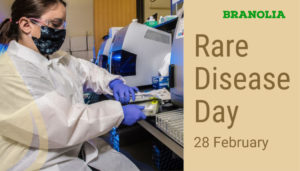The Rare Disease Day

According to World Health Organisation (WHO) a disease or disorder, when found to prevail in 1 person ( or less) per 1000 population, would fall into the category of Rare Disease. However it is more of a country-specific term and this number varies from county to country depending on the respective population, health care system, and resources. Rare Diseases although individually are uncommon, but common in the aggregate, with approximately 7,000 described rare diseases affecting nearly 4-5% of the global population. It has been found that 72 percent of such diseases are generic and 70 percent of those start in early childhood.
Rare Disease Day is held on the last day of February as an observance to build and spread awareness that has impacted over 300 million people worldwide.
Challenges
Rare diseases pose special challenges not only to the patient but also to the doctors who treat them, to the investigators who study their conditions, and ultimately the caregivers who have to take care of their wards.
- The magnitude of funding for rare disease research is disproportionately limited.
- Lack of adequate knowledge and experience of the disease by the patient community due to limited availability of official guidelines that are endorsed by official societies.
- Nonavailability of medicine or device in that geographical location and requiring patients to travel long distances for care or foregoing the treatment.
- Huge economic burden of due to delayed diagnosis –to diagnose a rare disease takes a lot of time, averaging between five to eight years.
- It poses a tremendous collective cost burden to the country, for eg it’s likely to cross $1 trillion annually in the United States alone.
Rare Disease- Policy in India
A disease or disorder is defined as ‘Rare’ In India when it affects fewer than 1 in 2500 individuals.
India has nearly 100 million people affected by rare diseases or disorders and the policy report said almost 80% of these rare condition patients are children and a leading cause for most of them not reaching adulthood is due to the high morbidity and mortality rates of these life-threatening diseases.
To address various challenges in the management and research of rare diseases, a comprehensive ‘National Policy for Rare Diseases 2021’ was approved by the Ministry of Health and Family Welfare, GOI, in march 2021. The policy aims to attain a lower high cost of treatment along with financial support with an increased focus on indigenous research.
Advocacy and observance of the day
Out of the countermeasures to overcome the challenges, probably the foremost is the emergence of various patient advocacy organizations worldwide, who act as catalysts in building relationships amongst the clinical, scientific, governmental, and pharmacy/device communities in service of supporting research to find cures and disease impact.
As per NIH, the largest biomedical research agency in the world, a part of the U.S. Department of Health and Human Services, who are the biggest sponsor of Rare Disease Day worldwide the objective of observing Rare Disease Day are to
- Showcase the research work as a commitment to helping people with rare diseases and the update on the development of diagnostics and treatments.
- Initiate a mutually beneficial dialogue among the rare diseases community.
- Exchange the news of the latest rare diseases information with stakeholders to advance research and therapeutic efforts.
- Shine a spotlight on stories told by people living with a rare disease, their families, and their communities.
- At present,106 counties are involved in observing the day with 600 plus events worldwide.
Branolia, a century-old ayurvedic pharmacy supports the medical researchers and laboratories worldwide which are racing to find cure for the rare diseases,
[supsystic-social-sharing id="1"]
